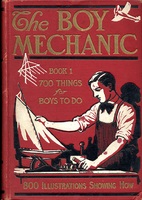 |
 |
|
 |
 |
From The Boy Showman and Entertainer by A Rose. Published 1930, London: George Routledge & Sons, Ltd.,
New York: E. P. Dutton & Co. The late Ralph Hyde, moving panorama historian,
emailed this article to me in 2013. The book is a collection of activities for children. Although large moving panoramas had long since died out by the 1930s, they carried on in a smaller version (sometimes known as parlor panoramas) as a children's activity.
The article suggests the window opening to be 18" X 24" which happens to be exactly the size of many crankies today.
I have included a couple excerpts below. The first gives ideas for a story
line. These were common scenes in both 19th century moving panoramas and magic lantern slides and are still relevant today, especially used along with shadow puppetry. The second section tells how to illuminate the moving panorama with candles.
The book is available on Amazon and Abe Books or you may be able to find the whole article on Google Books. Enjoy!
A Panorama
Makes a most interesting and artistic entertainment, and one that gives the pleasure in the making, apart from its exhibition to a delighted audience. In the showman has the necessary abilities in the
art of drawing and painting, the greater the pleasure in producing a panorama, it being a form of entertainment which has a tremendous range of subjects, as travel about and all over the world, history, science, zoological subjects, comic interludes, and stories
grave and gay. Then there are the mechanical and other effects, many of which may be not only beautiful, but most enchanting to the audience, as:
- sunrise and sunset taking part
in a picturesque landscape
- the moon rising and lighting up with waters of a lake or the sea, during which ships, sailing and otherwise, pass on their way.
- a city by day, and then by night, the windows in each building being lit up, as also the street lamps.
- the lighthouse with its warning light -
in this scene a storm may be represented, ith the wreck of some doomed ship which finally disappears beneath the waves.
- an animated scene at a railway station, with the arrival of a train,
and then its passing out of the station on its journey
- the next scene being a big liner in the docks, which conveys us in imagination to different parts of the universe.
Illuminating the Moving Panorama with Candles
Six short lengths of candle, each to burn for about an hour, will answer for the footlights with which to illuminate the different views. These candles are to be placed at the foot of the proscenium
front, and must have little tin reflectors in the front of each to screen the light from the eyes of the audience. the side of the reflectors facing the candles may be kept bright by polishing. The side towards the auditorium to be painted black.
Figure 1 is the back view of the pictures, or panorama. Now supposing that it is wished to present a view by night, showing the windows in the houses lit up, also the street lamps. To
get this interesting and pretty effect, the form of the buildings must be painted upon the back of the scene with some dark colour, as black or very deep blue, leaving the windows and lamp lights untouched, the sky being painted a medium-toned blue. The picture
is first shown as daytime, being lit up in front, then a narrow strip of tine painted black both sides is placed, or held by the assistant, in front of the footlights, so as to illuminate the scene very slightly. Now a fairly strong light (three or four candles)
illuminate the back of the scene, thus giving the effect of the city by night.
Moving Picture Toy for Children, from The Boy Mechanic, 1913
 There were numerous volumes of The Boy Mechanic published in the early 20th century. Image from "Library Thing" website.
There were numerous volumes of The Boy Mechanic published in the early 20th century. Image from "Library Thing" website.
This article is from The Boy Mechanic Series of books by Popular Mechanics and Henry Haven Windsor. The first book was published in 1913. I am trying to find out in which volume this article
appeared. Thank you to crankie artist Katherine Fahey for sending to me. ❤
The article is interesting from a historical standpoint and I love reading ALL the old "how
to" articles. However, I must say there are easier ways to go about it than the instructions below, so if you are making your first crankie, I would visit the "Make
a Crankie" section of the Crankie Factory website. If you do make a crankie following the directions below, please send some pictures or a video! I would love to see it!
First created 2017 - revised 2022, Sue Truman ❤
|
|
 |
|
|
|